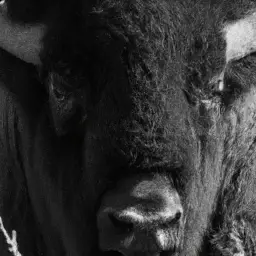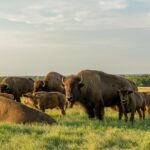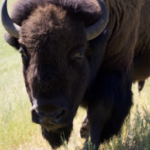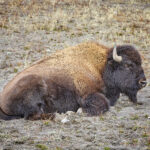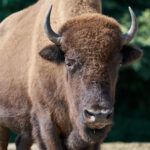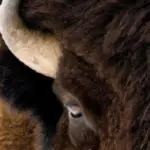Imagine being able to finally answer the age-old question of how many bison roam the vast expanses of the United States. With the groundbreaking product “How Many Bison Are There In The United States,” you can now uncover the precise numbers and gain a fascinating insight into these majestic creatures. This innovative tool provides an accurate count of the bison population, allowing you to delve into their fascinating world and appreciate their significance to the American landscape. Whether you’re a wildlife enthusiast or simply curious about these iconic animals, “How Many Bison Are There In The United States” is your key to unlocking a wealth of knowledge.
Historical Background of Bison in the United States
Overview of Bison’s existence in the U.S.
The American bison, also known as the American buffalo, once roamed the vast plains and prairies of North America in massive herds. Bison have a rich history in the United States, with evidence suggesting their presence for thousands of years. Native American tribes revered and relied on the bison for their survival, utilizing almost every part of the animal. The arrival of European settlers, however, drastically impacted the bison populations.
Impact of colonization on Bison populations
With the colonization of North America by Europeans came the rapid decline of bison populations. Settlers, primarily in the 19th century, engaged in mass hunting and commercial exploitation of bison for their hides, meat, and other resources. Overhunting, combined with habitat loss due to agricultural expansion and encroachment by railroads, led to a sharp decline in the bison population, pushing them to the brink of extinction.
Efforts towards Bison extinction
The intentional efforts to eradicate bison during the colonization period were part of a strategy to subdue Native American tribes, who depended on bison for their sustenance and way of life. Mass hunting, destruction of bison herds, and the decimation of their habitats nearly drove the bison to extinction. By the late 1800s, the once-thriving population of millions had been reduced to a mere few hundred individuals, scattered across remote areas of the United States.
Current Estimation of Bison Population
Latest Bison population count in the U.S.
Thanks to dedicated conservation efforts, the bison population in the United States has made a remarkable recovery. According to the 2021 Bison Conservation Status Report by the U.S. Fish and Wildlife Service, the estimated total number of bison in the United States is around 31,000 individuals. This number includes both wild and privately owned bison herds.
Growth rate of Bison population
The bison population has shown a positive growth trend in recent years. From a low point of around 1,000 individuals in the late 1800s, the population has seen a steady increase. The growth rate of the bison population varies among different herds and regions, with some populations experiencing higher growth rates than others. Nevertheless, overall, efforts to restore the bison population have been successful, although the numbers are still far from their historical levels.
Factors contributing to current population size
The current increase in the bison population can be attributed to various factors. First and foremost, conservation efforts by government agencies, non-governmental organizations, and private landowners have played a crucial role in protecting and restoring bison habitats. Additionally, the establishment of protected areas, such as national parks and wildlife refuges, has provided safe havens for bison to thrive. Furthermore, controlled breeding programs and reintroduction initiatives have helped in boosting the population size.
Methods Used in Counting Bison
Traditional counting methods
Traditionally, bison population counts were conducted through visual surveys or aerial reconnaissance. Experts, often aided by local knowledge, would estimate the number of bison in a particular area by observing herd sizes and densities. This method, although subjective and prone to errors, provided a rough estimation of the population.
Modern techniques and technologies
Today, advancements in technology have revolutionized bison counting methods. Biologists and researchers now utilize techniques such as infrared and thermal imaging, remote sensing, and camera traps to obtain more accurate population estimates. These modern methods allow for non-invasive, automated data collection and analysis, reducing human bias and improving overall accuracy.
Accuracy and challenges of Bison counting
Counting bison accurately can be challenging due to various factors. Bison herds are mobile and can cover vast areas, making it difficult to monitor and track them consistently. Additionally, dense vegetation, rugged terrain, and harsh weather conditions can hinder visibility and affect the accuracy of visual surveys. Moreover, counting privately-owned bison herds can be more challenging due to limited access and cooperation from landowners.
Geographical Distribution of Bison Across the U.S.
Bison habitats in the U.S.
Bison have recolonized parts of their historical range across the United States. They can now be found in various habitats, including grasslands, prairies, shrublands, and even forested areas. Bison have been successfully reintroduced in national parks, tribal lands, wildlife refuges, and private ranches, which provide suitable conditions for their survival and reproduction.
States with highest Bison populations
The largest populations of bison in the United States are concentrated in states such as Montana, Wyoming, South Dakota, and North Dakota. These states offer expansive landscapes with suitable grassland habitats that can support bison herds. Additionally, areas like Yellowstone National Park and Wind Cave National Park have been critical for bison conservation and harbor significant populations.
Factors influencing geographical distribution
Several factors influence the geographical distribution of bison in the United States. Availability of suitable habitat, including access to grazing areas, water sources, and shelter, plays a crucial role. Land management practices and the presence of protected areas or private lands dedicated to bison conservation also impact the distribution. Additionally, historical factors, including the location of original herds and patterns of bison movement, can influence the current distribution.
Role of Bison in Ecosystem
Importance of maintaining Bison population
Bison play a vital role in maintaining the health and biodiversity of grassland ecosystems. As herbivores, they shape the landscape through their grazing behavior, promoting the growth of diverse plant species. By selectively feeding on grasses, bison prevent woody encroachment and maintain open habitats, benefiting numerous other plant and animal species.
Bison as apex consumer in grassland ecosystem
Within the grassland ecosystem, bison occupy the role of an apex consumer. They consume vast amounts of plant material, facilitating nutrient cycling and increasing soil fertility. Their grazing behavior also helps create a mosaic of different vegetation types, which in turn supports a diverse array of grassland-dependent species, including insects, birds, and small mammals.
Impact of Bison on biodiversity and other species
Bison’s presence has a cascading effect on the biodiversity of grassland ecosystems. Their grazing patterns create a diverse range of habitats for various plant species, which in turn attracts an abundance of insects, birds, and other animals. Bison wallows and dust bathing sites also provide valuable microhabitats for amphibians, reptiles, and insects. Overall, maintaining a healthy bison population ensures the conservation of numerous plant and animal species dependent on grassland ecosystems.
Threats to Bison Population in the U.S.
Hunting pressures on Bison
Although hunting pressures on bison have significantly declined since the 19th century, illegal hunting and poaching still pose a threat to their population. Unregulated hunting or the illegal harvest of bison can disrupt population dynamics, deplete genetic diversity, and impede conservation efforts. It is crucial to enforce wildlife protection laws and promote responsible hunting practices to mitigate this threat.
Disease-related threats
Bison populations are vulnerable to various diseases, such as brucellosis and bovine tuberculosis, which can have devastating effects. These diseases can spread among individuals within a herd or to other wildlife and livestock, posing risks to both the health of the bison and human livelihoods. Disease surveillance, vaccination programs, and implementing proper management strategies are essential for preventing and controlling disease outbreaks.
Impact of climate change and other environmental factors
Climate change poses significant challenges to the long-term survival of bison populations. Alterations in precipitation patterns, temperature extremes, and the spread of invasive species can negatively affect bison habitats and their food resources. Habitat degradation, loss of forage availability, and increased competition from other herbivores due to changing climate conditions can all impact the population dynamics of bison.
Conservation Efforts for the Bison Population
Role of government and non-government organisations
Conservation efforts for the bison population involve collaborations between government agencies, non-governmental organizations (NGOs), tribal communities, and private landowners. These entities work together to protect and restore bison habitats, implement breeding programs, monitor populations, and advocate for policies that support bison conservation.
Wildlife protection laws and regulations
Legal frameworks and regulations play a crucial role in protecting bison populations. The U.S. federal government, through agencies such as the U.S. Fish and Wildlife Service and the National Park Service, enacts and enforces laws related to wildlife conservation. Additionally, various state-specific regulations and agreements with tribal nations help safeguard bison populations and their habitats.
Bison reintroduction programs
Reintroduction programs have been instrumental in reestablishing bison populations in areas where they were once extirpated. Government agencies, NGOs, and private landowners have collaborated to reintroduce bison into national parks, preserves, and tribal lands. These programs aim to restore the ecological role of bison and ensure their long-term viability.
Success and challenges of conservation efforts
Conservation efforts for bison populations have yielded significant successes, with population numbers recovering from historical lows. However, challenges remain, including habitat fragmentation, genetic bottlenecks due to small population sizes, and conflicts between bison and neighboring land uses. Continued efforts to address these challenges through collaborative management and adaptive strategies are essential for the long-term success of bison conservation.
Bison’s Significance to Native American Cultures
Historical importance of Bison
Bison have been of immense cultural and historical significance to Native American tribes for thousands of years. Tribes such as the Lakota, Cheyenne, and Blackfeet have deep cultural connections and traditional practices centered around bison. Bison provided Native Americans with food, clothing, shelter, and tools, becoming an integral part of their way of life.
Role in religious and ceremonial practices
Bison hold spiritual importance in many Native American religions and ceremonial practices. Their presence is often associated with strength, abundance, and a connection to the earth. Various rituals and ceremonies are dedicated to honoring the bison and expressing gratitude for their gifts.
Use in crafting and sustenance
The various parts of the bison were utilized by Native American tribes for crafting and sustenance. Bison hides were tanned and used to make clothing, tipi covers, and other items. Bones and sinews were fashioned into tools, while hooves and horns were transformed into ornamental and functional objects. Bison meat provided a vital source of nourishment for tribes, and no part of the animal went to waste.
Economic Impact of Bison in the U.S.
Bison in the tourism industry
The presence of bison in national parks, wildlife refuges, and ranches has contributed significantly to the tourism industry in the United States. Bison viewing and photography have become popular attractions, drawing visitors from around the world. Bison also play a vital role in cultural tourism, as tourists engage in educational experiences centered around Native American history and conservation efforts.
Commercial farming and hunting of Bison
Bison farming has become a thriving industry, driven by the demand for bison meat, hides, and other byproducts. Commercial farming practices, while controversial due to concerns about genetic purity and animal welfare, have helped increase the availability of bison products in the market. Additionally, regulated hunting of bison provides economic opportunities for local communities and supports wildlife management efforts.
Economic values attributed to Bison
Bison contribute to local economies through various avenues, including agritourism, sale of bison products, and job creation. The economic values attributed to bison encompass direct revenue from tourism and commercial activities, as well as indirect benefits such as ecological services provided by healthy and diverse grassland ecosystems.
How Many Bison Species Are Found in the United States?
There are two species of bison available in the United States: the plains bison and the wood bison. These magnificent creatures once roamed North America in the millions and are now a symbol of conservation efforts to protect their populations and habitats.
Future Projections for Bison Population in the U.S.
Projected population growth
Based on current conservation efforts and positive population trends, it is expected that the bison population in the United States will continue to grow in the foreseeable future. Reintroduction programs, habitat restoration, and the commitment of various stakeholders pave the way for continued population expansion.
Impact of ongoing conservation efforts
Ongoing conservation efforts remain critical for the long-term survival of bison populations. Continued partnerships between government agencies, NGOs, tribal communities, and private landowners are necessary to ensure the protection and restoration of bison habitats. Monitoring, adaptive management, and addressing emerging threats, such as climate change, will be key in sustaining the progress made thus far.
Long-term survival strategies for Bison population in the U.S.
To secure the long-term survival of bison populations in the United States, a multi-faceted approach is needed. This includes strengthening protected areas, promoting habitat connectivity, managing bison genetics, conducting research on disease prevention and management, and engaging local communities in conservation efforts. By implementing comprehensive strategies, we can ensure the continued presence of bison, preserving their ecological, cultural, and economic significance for generations to come.

